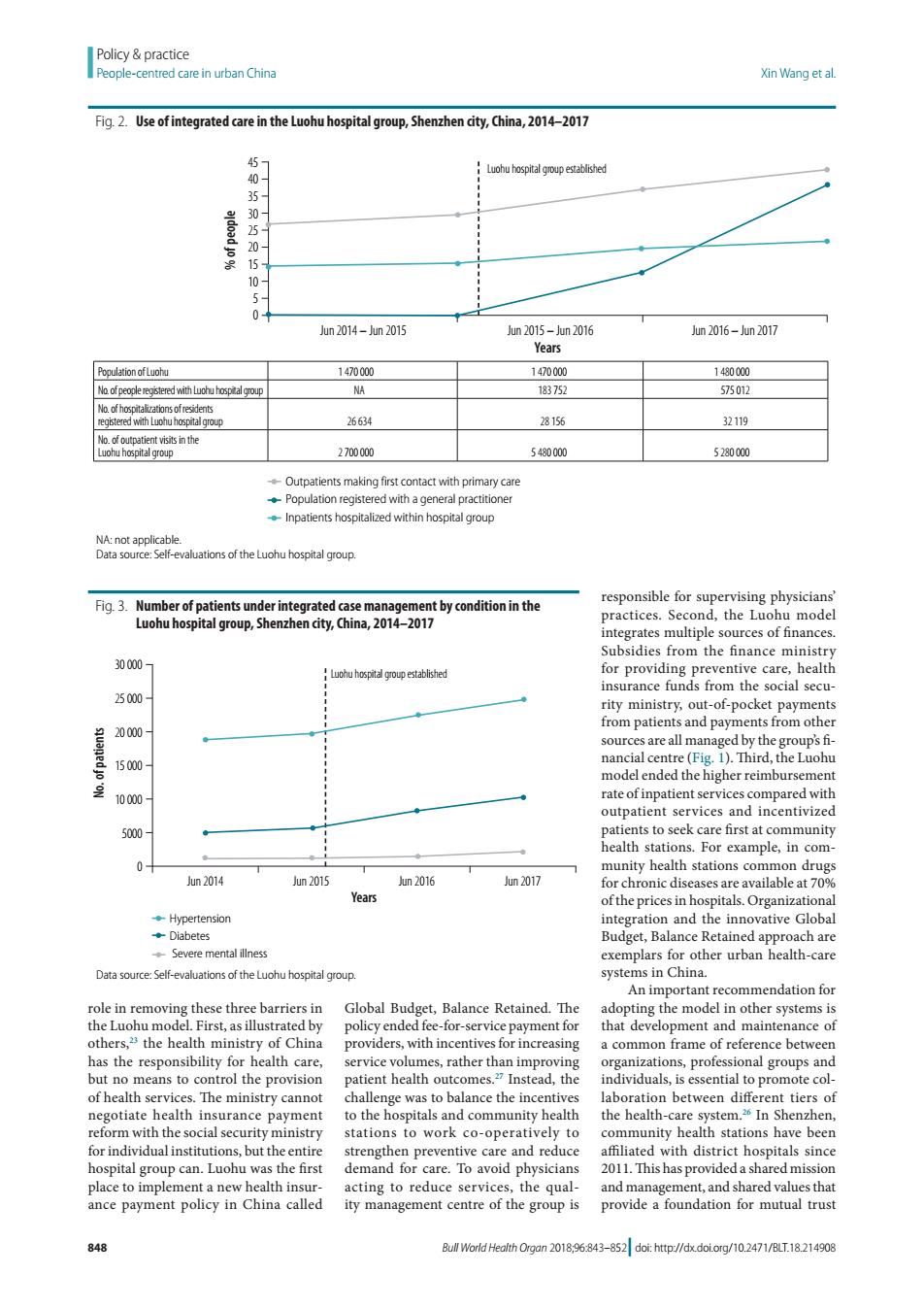正在加载图片...

Policy practice People-centred care in urban China Xin Wang et al. Fig.2.Use of integrated care in the Luohu hospital group,Shenzhen city,China,2014-2017 457 Luohu hospital goup established 40- 35- 5、 0 15 10- 5- 0- Jun2014-Jun2015 Jun2015-Jun2016 Jun2016-Jun2017 Years PopulationofLuohu 1470000 1470000 1480000 No of people egistered with uohu hosptal group NA 183752 575012 No.of hospitalizations of residents eistered with Luohu hospita group 26634 28156 32119 No.visits in the Luohu hospital group 2700000 5480000 5280000 Outpatients making first contact with primary care -Population registered with a general practitioner Inpatients hospitalized within hospital group NA:not applicable. Data source:Self-evaluations of the Luohu hospital group. Fig.3.Number of patients under integrated case management by condition in the responsible for supervising physicians' Luohu hospital group,Shenzhen city,China,2014-2017 practices.Second,the Luohu model integrates multiple sources of finances. Subsidies from the finance ministry 30000- huhospita goupestablished for providing preventive care,health insurance funds from the social secu- 25000 rity ministry,out-of-pocket payments from patients and payments from other 20000 sources are all managed by the group's fi- 15000 nancial centre(Fig.1).Third,the Luohu model ended the higher reimbursement 10000 rate of inpatient services compared with outpatient services and incentivized 5000 patients to seek care first at community health stations.For example,in com 0- munity health stations common drugs Jun 2014 un2015 Jun 2016 Jun 2017 for chronic diseases are available at 70% Years of the prices in hospitals.Organizational ◆Hypertension integration and the innovative Global Diabetes Budget,Balance Retained approach are Severe mental illness exemplars for other urban health-care Data source:Self-evaluations of the Luohu hospital group. systems in China. An important recommendation for role in removing these three barriers in Global Budget,Balance Retained.The adopting the model in other systems is the Luohu model.First,as illustrated by policy ended fee-for-service payment for that development and maintenance of others,"the health ministry of China providers,with incentives for increasing a common frame of reference between has the responsibility for health care, service volumes,rather than improving organizations,professional groups and but no means to control the provision patient health outcomes.27 Instead,the individuals,is essential to promote col- of health services.The ministry cannot challenge was to balance the incentives laboration between different tiers of negotiate health insurance payment to the hospitals and community health the health-care system.2 In Shenzhen, reform with the social security ministry stations to work co-operatively to community health stations have been for individual institutions,but the entire strengthen preventive care and reduce affiliated with district hospitals since hospital group can.Luohu was the first demand for care.To avoid physicians 2011.This has provided a shared mission place to implement a new health insur- acting to reduce services,the qual- and management,and shared values that ance payment policy in China called ity management centre of the group is provide a foundation for mutual trust 848 Bull World Hea/th Organ 2018:96:843-852 doi:http://dx.doi.org/10.2471/BLT.18.214908848 Bull World Health Organ 2018;96:843–852| doi: http://dx.doi.org/10.2471/BLT.18.214908 Policy & practice People-centred care in urban China Xin Wang et al. role in removing these three barriers in the Luohu model. First, as illustrated by others,23 the health ministry of China has the responsibility for health care, but no means to control the provision of health services. The ministry cannot negotiate health insurance payment reform with the social security ministry for individual institutions, but the entire hospital group can. Luohu was the first place to implement a new health insurance payment policy in China called Global Budget, Balance Retained. The policy ended fee-for-service payment for providers, with incentives for increasing service volumes, rather than improving patient health outcomes.27 Instead, the challenge was to balance the incentives to the hospitals and community health stations to work co-operatively to strengthen preventive care and reduce demand for care. To avoid physicians acting to reduce services, the quality management centre of the group is responsible for supervising physicians’ practices. Second, the Luohu model integrates multiple sources of finances. Subsidies from the finance ministry for providing preventive care, health insurance funds from the social security ministry, out-of-pocket payments from patients and payments from other sources are all managed by the group’s financial centre (Fig. 1). Third, the Luohu model ended the higher reimbursement rate of inpatient services compared with outpatient services and incentivized patients to seek care first at community health stations. For example, in community health stations common drugs for chronic diseases are available at 70% of the prices in hospitals. Organizational integration and the innovative Global Budget, Balance Retained approach are exemplars for other urban health-care systems in China. An important recommendation for adopting the model in other systems is that development and maintenance of a common frame of reference between organizations, professional groups and individuals, is essential to promote collaboration between different tiers of the health-care system.26 In Shenzhen, community health stations have been affiliated with district hospitals since 2011. This has provided a shared mission and management, and shared values that provide a foundation for mutual trust Fig. 3. Number of patients under integrated case management by condition in the Luohu hospital group, Shenzhen city, China, 2014–2017 Years Hypertension Diabetes Severe mental illness Jun 2014 Jun 2015 Jun 2016 Jun 2017 No. of patients 30 000 25 000 20 000 15 000 10 000 5000 0 Luohu hospital group established Data source: Self-evaluations of the Luohu hospital group. Fig. 2. Use of integrated care in the Luohu hospital group, Shenzhen city, China, 2014–2017 % of people 45 40 35 30 25 20 15 10 5 0 Years Outpatients making first contact with primary care Population registered with a general practitioner Inpatients hospitalized within hospital group Jun 2014 – Jun 2015 Jun 2015 – Jun 2016 Jun 2016 – Jun 2017 Population of Luohu 1470 000 1 470 000 1 480 000 No. of people registered with Luohu hospital group NA 183 752 575 012 No. of hospitalizations of residents registered with Luohu hospital group 26 634 28 156 32 119 No. of outpatient visits in the Luohu hospital group 2700 000 5480 000 5280 000 Luohu hospital group established NA: not applicable. Data source: Self-evaluations of the Luohu hospital group